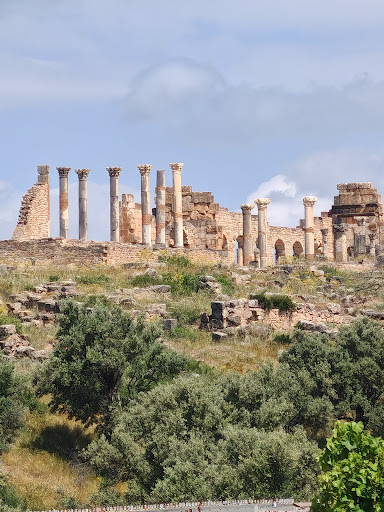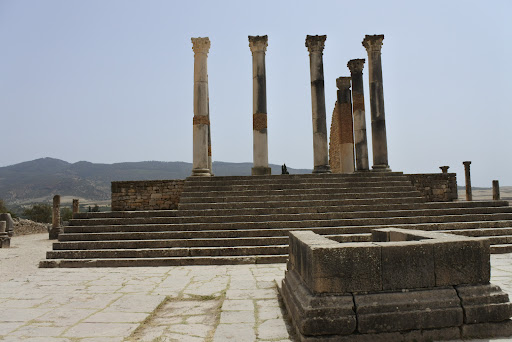Located in Morocco, the Site Archéologique de Volubilis is a historical landmark of great significance. It has been designated as a UNESCO World Heritage Site due to its remarkable preservation as a substantial Roman colonial town on the fringes of the Empire. Volubilis, a partly excavated Berber-Roman city in Morocco, is situated near Meknes, Morocco, and may have been the capital of the Kingdom of Maurerania, at least during King Juba II's reign. Before Volubilis, Gilda may have been the capital of the kingdom.
Situated in a fertile agricultural region, the city emerged from the 3rd century BC as a Berber settlement, later influenced by proto-Carthaginian culture, before becoming the capital of the kingdom of Mauretania. The city underwent significant development in the 2nd century, marked by the construction of notable public buildings, including a basilica, temple, and triumphal arch. The city's prosperity, primarily driven by olive cultivation, prompted the construction of numerous townhouses adorned with intricate mosaic floors. The site was definitively identified as the ancient city of Volubilis in the late 19th century. Following the period of French rule over Morocco, approximately half of the site was excavated, revealing exquisite mosaics, and several prominent public buildings and high-status houses were restored or reconstructed.
Numerous private structures, including the opulent residences of the city's upper echelon, have also been unearthed. These buildings are particularly distinguished by the exquisite mosaics that have been discovered in several structures and remain in situ within the houses where they were originally laid. Two prominent public buildings are readily visible at the city's center – the basilica and the Capitoline Temple. The basilica served as a venue for the administration of justice and municipal governance. The Capitoline Temple stands behind the basilica within what would have originally been an arcaded courtyard.
Our visit to Volubilis was time-constrained, with the guide allowing insufficient time for exploration and photography. Nonetheless, the site proved enlightening for architectural enthusiasts like myself. Although smaller in scale compared to the Colosseum and Roman Forum in Rome, as well as certain Roman ruins in Greece, Volubilis remains a significant historical site. Unfortunately, I was unable to locate documentation from my previous architectural study tours in Greece and Rome, which I would have liked to share. This may serve as motivation for revisiting these locations...
Read moreVolubilis stands as a remarkable testament to Roman architectural brilliance in North Africa. The ancient ruins showcase exquisite mosaic floors, impressive columns, and well-preserved structures that offer fascinating insights into Roman urban planning and daily life. The triumphal arch and the basilica are particularly striking, while the detailed mosaics in the wealthy merchants' houses reveal the site's former grandeur and sophistication.
As a UNESCO World Heritage site, it holds immense historical and cultural significance, representing the furthest reaches of the Roman Empire in Africa. The blend of Roman and indigenous cultures visible in the archaeological remains makes it a unique historical treasure.
However, the visitor experience is severely compromised by concerning issues. The entrance fee of $10 is steep, with additional charges for basic facilities like restrooms. Most disturbing is the dishonest behavior at the cafe, where the manager deliberately attempts to shortchange visitors. They employ a deceptive coin manipulation trick, trying to convince you that you paid with lower-value coins than you actually did - a practice that shows complete disregard for tourist trust.
While the ruins themselves are a magnificent window into Roman civilization, such unethical practices and poor management severely detract from the experience. It's particularly disappointing that a site of such historical significance is tainted by these unprofessional and dishonest practices. For those who have seen Rome's archaeological sites, the combination of high costs and questionable service might make this visit less worthwhile, despite the undeniable beauty of the...
Read moreArchaeological site of Volubilis Under preservation of UNESCO
The Mauritanian capital, founded in the 3rd century BC, became an important outpost of the Roman Empire and was graced with many fine buildings. Extensive remains of these survive in the archaeological site, located in a fertile agricultural area. Volubilis was later briefly to become the capital of Idris I, founder of the Idrisid dynasty, who is buried at nearby Moulay Idris.
Volubilis contains essentially Roman vestiges of a fortified municipium built on a commanding site at the foot of the Jebel Zerhoun. Covering an area of 42 hectares, it is of outstanding importance demonstrating urban development and Romanisation at the frontiers of the Roman Empire and the graphic illustration of the interface between the Roman and indigenous cultures. Because of its isolation and the fact that it had not been occupied for nearly a thousand years, it presents an important level of authenticity. It is one of the richest sites of this period in North Africa, not only for its ruins but also for the great wealth of its epigraphic evidence.
Place worthy of visit, lots of rich history at this site and there is even more to discover, at this moment they are renovating the new area.
you can get your own guided tour from the entrance by 200dirham if you arrive by car
Our guide was named Hassan who was really experienced and knew everything about the site, highly recommend this guide. Speaks...
Read more


